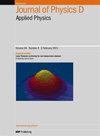利用 BN 共掺杂实现相纸单层的卓越热传输
IF 3.2
3区 物理与天体物理
Q2 PHYSICS, APPLIED
引用次数: 0
摘要
在本研究中,我们通过第一性原理计算结合机器学习原子间势(MLIP)技术,深入探讨了掺杂 BN 的相思结构的热传输和热电性能。我们的研究结果表明,掺杂位置可以对热特性进行关键调整,从而为热电和传热应用提供潜在优势。值得注意的是,掺杂了 10 个共掺物的法拉吩的热导率得到了增强。此外,石墨烯的矩形结构对称性在有针对性的热传输中发挥了重要作用。此外,我们还在这些结构中观察到负的格鲁尼森参数,这表明它们具有负热膨胀性。这将成为控制不同频率下热导率的独特机制。有趣的是,这些结构的 n 型行为表明其在 300-900 K 温度范围内具有负塞贝克系数。此外,在 300 K 的恒定弛豫时间条件下,计算得出的结构优越性数据显示,某些特定掺杂结构的响应要好得多。我们相信,这项研究将对理解结构修饰在定制碳基二维系统热特性方面的重要性起到重要作用。本文章由计算机程序翻译,如有差异,请以英文原文为准。
Harnessing BN co-doping for superior thermal transport in phagraphene monolayer
In this study, we thoroughly explored the thermal transport and thermoelectric properties of BN-co-doped phagraphene structures in the context of first-principles computations combined with machine learning interatomic potential (MLIP) techniques. Our results demonstrate that doping positions can critically tune the thermal properties, offering potential advantages for both thermoelectric and heat transfer applications. Notably, enhanced thermal conductivity has been obtained for phagraphene with 10 co-doping. Additionally, the rectangular structural symmetry of phagraphene plays an important role for targeted thermal transport. Further, we observe negative Grüneisen parameter in these structures, suggesting negative thermal expansion. This will serves as an unique mechanism for controlling the thermal conductivity at different frequencies. Interestingly, n-type behavior of the structures is indicative of its negative Seebeck coefficient within the temperature range of 300–900 K. Moreover, these structures display significantly larger electrical conductivity compared to other two-dimensional (2D) materials. Apart from that, the calculated figure of merit of the structures under a constant relaxation time at 300 K shows considerably better response for some specific doped structures. We believe this study will play an important role in understanding the importance of structural modifications in tailoring the thermal properties of carbon-based 2D systems.
求助全文
通过发布文献求助,成功后即可免费获取论文全文。
去求助
来源期刊
CiteScore
6.80
自引率
8.80%
发文量
835
审稿时长
2.1 months
期刊介绍:
This journal is concerned with all aspects of applied physics research, from biophysics, magnetism, plasmas and semiconductors to the structure and properties of matter.

 求助内容:
求助内容: 应助结果提醒方式:
应助结果提醒方式:


